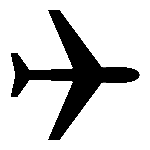
Traffic information service – broadcast (TIS–B) is an aviation information service that allows pilots to see aircraft that are not emitting ADS-B data but have a basic transponder.
As aircraft are discovered by primary radar and respond with encoded altitude information, this information is broadcast over ADS-B. These near real time positions and ground tracks of other nearby aircraft are provided for the purpose of collision avoidance. It presents to the pilot a combined representation of aircraft positions derived from GPS satellite and ground-based radar data, specifically: aircraft's replies to ATC interrogations (i.e., they are responses to queries as sent to the aircraft from air traffic controller on the ground).[1][2]
TIS-B is broadcast to aircraft using both the 1090 MHz extended squitter (1090 ES) and the universal access transceiver (UAT) band of Automatic Dependent Surveillance–Broadcast (ADS-B).[3] Currently the service mainly benefits general aviation (GA) aircraft equipped with ADS-B "in" hardware by providing a traffic information relay to a screen in the cockpit.
At this time TIS–B is meant to be only a supplement to visual separation from other aircraft when operating in visual meteorological conditions (VMC) and as a backup to radar, which in remote areas only updates every 13 seconds, when operating under instrument flight rules (IFR).[4]
References
[edit]- ^ "Ins and Outs". faa.gov. 15 April 2022. Retrieved 18 June 2022.
To qualify as a TIS-B target, an aircraft must be equipped with a transponder, and be within radar coverage.
- ^ "AC 900114B Automatic Dependent Surveillance-Broadcast Operations" (PDF). faa.gov. 30 December 2019. Retrieved 18 June 2022.
2 TIS-B. TIS-B is the broadcast of transponder-based Mode C or Mode S traffic information derived from ATC surveillance systems. TIS-B provides ADS-B In-equipped aircraft with a more complete picture of surrounding traffic in situations where not all aircraft are equipped with ADS-B. An aircraft or vehicle that is ADS-B Out and is receiving TIS-B service is known as a TIS-B client. A non-ADS-B-equipped aircraft or vehicle that has its position transmitted in TIS-B reports is known as a TIS-B target. See paragraph 2.3.5 for TIS-B client qualification criteria.
- ^ "New Technology – ADS-B, TIS-B, and FIS-B" (PDF). FAA - Air Traffic Bulletin - Special. August 2005. Archived from the original (PDF) on 21 September 2012.
- ^ Tom Benenson (30 October 2005). "Mysteries of ADS-B - FLYING Magazine". FLYING Magazine. Retrieved 18 June 2022.
The uplink of non-ADS-B traffic is referred to as Traffic Information Service-Broadcast (TIS-B). Because the uplinked radar information is not as accurate as the ADS-B targets, the icon on the cockpit display for "degraded" non-ADS-B traffic looks a bit like a Pacman that's had a bite taken out of its backside; the ADS-B traffic is displayed as a chevron or arrow head pointing in its direction of movement.});
Well, that’s interesting to know that Psilotum nudum are known as whisk ferns. Psilotum nudum is the commoner species of the two. While the P. flaccidum is a rare species and is found in the tropical islands. Both the species are usually epiphytic in habit and grow upon tree ferns. These species may also be terrestrial and grow in humus or in the crevices of the rocks.
View the detailed Guide of Psilotum nudum: Detailed Study Of Psilotum Nudum (Whisk Fern), Classification, Anatomy, Reproduction